- Ariel LeBeau
- Austin Robey
- David Blumenstein
- David Ehrlichman
- David Kerr
- Devon Moore
- Dexter Tortoriello
- Drew Coffman
- Drew Millard
- Eileen Isagon Skyers
- FWB Staff
- Greg Bresnitz
- Greta Rainbow
- Ian Rogers
- Jessica Klein
- Jose Mejia
- Kelani Nichole
- Kelsie Nabben
- Kevin Munger
- Khalila Douze
- Kinjal Shah
- LUKSO
- Lindsay Howard
- Maelstrom
- Marc Moglen
- Marvin Lin
- Mary Carreon
- Matt Newberg
- Mike Pearl
- Mike Sunda (PUSH)
- Moyosore Briggs
- Nicole Froio
- Ruby Justice Thelot
- Simon Hudson
- Steph Alinsug
- The Blockchain Socialist
- Willa Köerner
- Yana Sosnovskaya
- Yancey Strickler
- iz

Fri Jun 03 2022
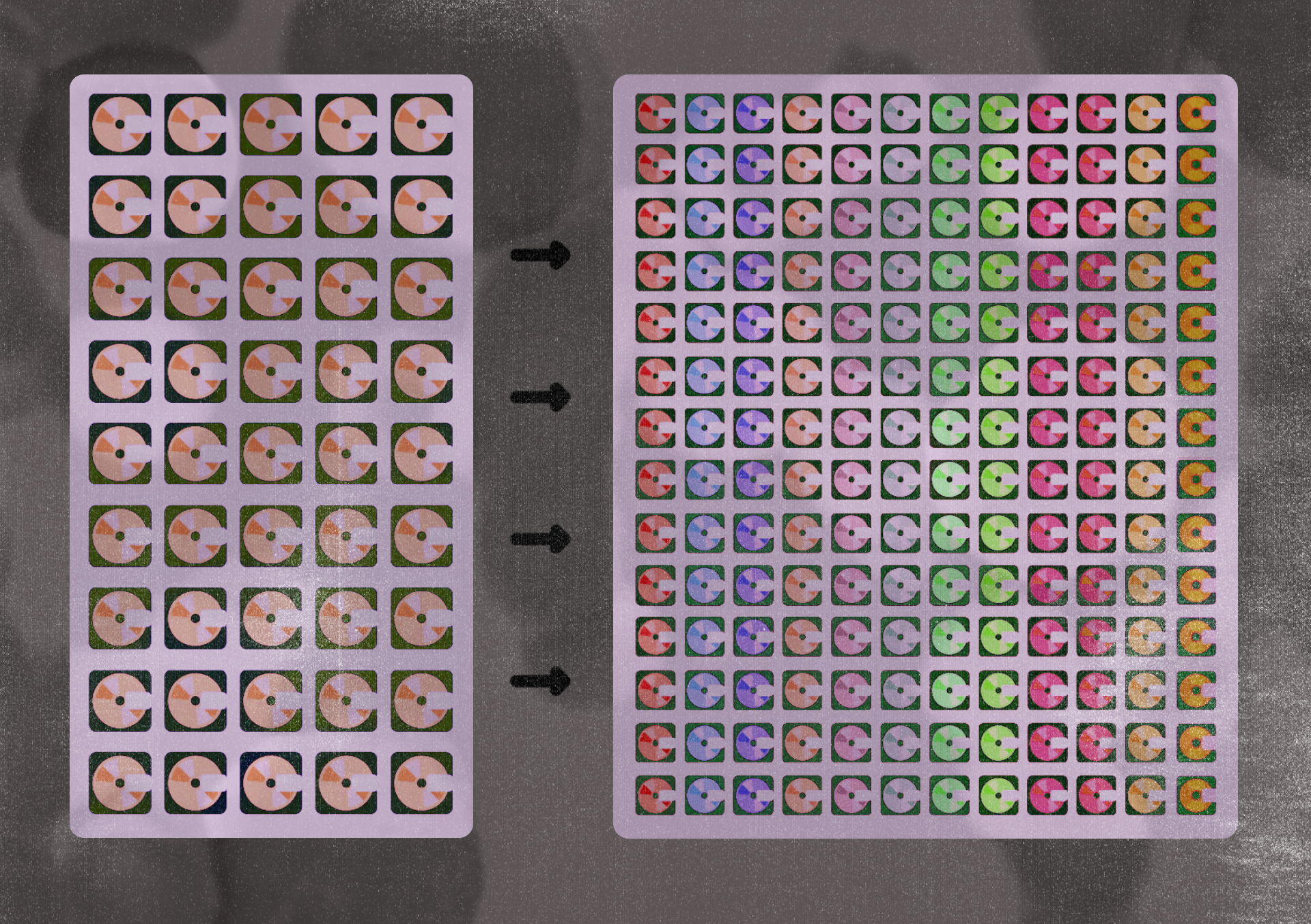
In a 2019 essay, the applied research organization known as Other Internet introduced a conceptual primitive called "Headless Brands." The authors use the idea to describe an emerging model of blockchain-based branding: Rather than adopt the hierarchical brand logic of traditional corporations, headless brands like Bitcoin reproduce coherent brand identities and mobilize coordinated actions without centralized managerial bodies, acting as community-driven consensus systems within decentralized networks.
Two and a half years and a pandemic later, we have Chaos, a group of musicians, visual artists, engineers, economists, lore masters, and more behind the internet’s first-ever "headless band." Incubated by the Web3 music lab Songcamp, the project saw this decentralized cohort of 77 artists embark on a wild Web3 experiment: What would it look like to collectively create music, artwork, tokenomics, lore, a novel distribution mechanic, a website, and custom smart contracts within an intense eight-week timeframe? What would it be like to lean into chaos?
The massive NFT project that resulted, and that is available to mint on Friday, June 3, centers a collection of 45 songs, which the group’s 45 participating musicians created in groups of three, breaking into a new trio configuration every two weeks according to rules established under Chaos's elaborate, multi-layered lore mechanics. The lore — which includes an enigmatic character named Eris, the “Goddess of Discord,” and a narrative about Order, Disorder, Entropy, and Rebirth — was designed to emphasize “a new dimension of chaotic co-creation.” It’s also reflected in how they're releasing the project: Rather than release the music as an album or as individual songs, Chaos is bundling them into 5,000 NFT "packs," similar to Pokémon cards. Supporters can choose to keep their Chaos Pack sealed as a collector's item, or burn it to reveal four random music NFTs, each with varying rarity traits and its own generative visual artwork. Were collectors to open every pack, the collection would total over 20,000 music NFTs.
The complexity of Chaos's collaboration strategies and release methodology is matched only by the project’s compensation structure. While the full details are beyond the scope of this piece (you can read more about the project here), the value-flow model itself is a work of art: Contributors received a one-time base universal basic income payment of 0.3 ETH two weeks into the project, while also benefiting from a smart contract titled Chaos Split. The latter uses a complex system of weights to determine how revenue from NFT sales will be distributed among the project’s many contributors, based on participants’ subjective evaluation of their own contribution, their recognition of the contributions of their peers, and the project’s commitment to rewarding labor that may have been undervalued or overlooked throughout the project. It also introduces a value-flow mechanism that is the first of its kind in the NFT space: Chaos is calling it "liquid splits," and it allows an artist's ownership percentage to actually be tradeable.
Works in Progress spoke with core contributors Matthew Chaim and Mark Redito — who are also FWB members — and Greydient about the story behind Chaos, the role that lore played in shaping its direction, and the degree of coordination required to organize such a chaotic mess of an adventure.
Join the Songcamp crew at 4 p.m. ET on mint day for Chaos Festival, a Discord party with live performances and special guests.
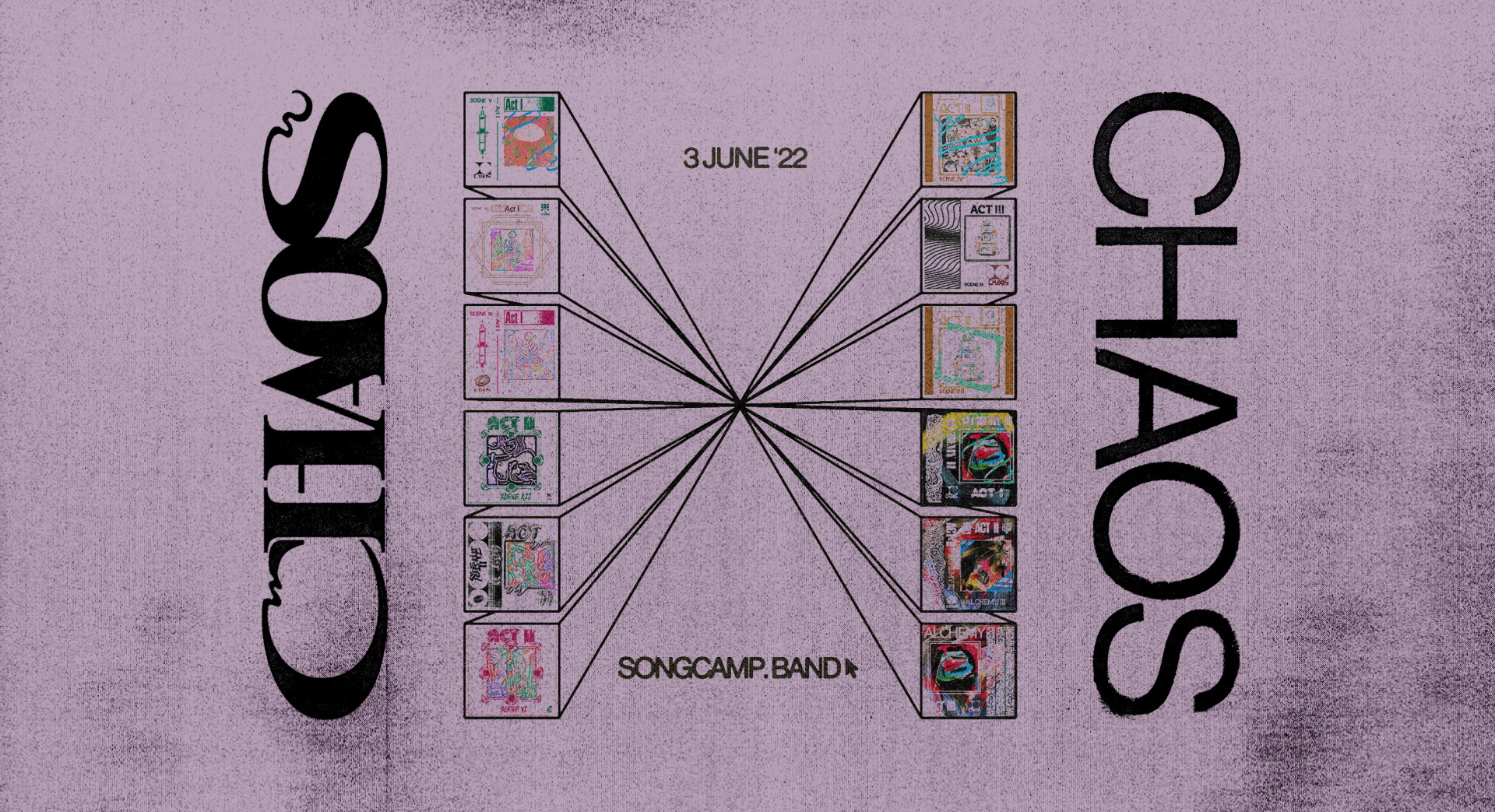
This should be a softball question, but maybe it’s not: What is Chaos?
Matthew Chaim, project steward, operations: [Chaos is] a “headless band” of 77 artists. We chose the name Chaos because, through our projects — namely through Elektra [the second Songcamp Camp, preceding Chaos] — we recognized that the convergence of musicians and [artists] in general and us creating online was a chaotic experience. What if we actually leaned into that? What if that became our identity for a certain period of time?
Mark Redito, music steward, operations: It was also, What would it look like to gather all of these artists — creative, talented people — to serve one singular artistic vision, and for that vision to be called Chaos? I think that has been our guiding light as this project moved on.
One of my favorite moments in the “Headless Brands” essay by Other Internet reads: “A brand lives in the minds of those who are aware of it [...] In this way, a brand operates as a consensus system, facilitating a consistent set of beliefs across people." How did this article influence how you all thought about Chaos?
Mark: I'm a big fan of that article, and it personally shaped my understanding of what this project is. One concept that stood out to me was “personalities as single points of failure,” which is applicable to the Chaos project: There's no single personality here. All of us released our artist ego in service of this one singular artist. And so, once you establish that prompt, there are all sorts of questions that emerge: What would it look like if an artist collective had no singular leader, but [everyone was moving] toward the same creative direction? What would it look like if all the members of this collective were its creative directors, its economists, its builders, its governors? Another thing is that the members all collectively hold the intellectual property rights of this body of work, which I think is quite novel. Where else have you seen 77 artists actually own, collectively, an IP?
Matthew: The article was very influential to me, too. It came to me through Samsonite from Seed Club and Camp Genesis [Songcamp’s first camp], who was also bringing up the term “headless band.” But Mat Dryhurst was also tweeting about it, and he was very influential to me even before Songcamp began. After Camp Genesis, he [tweeted about] the auctions of our music and was like, “This hints at a headless band, of what it would be like to create a band with a thousand artists,” or something like that. And that really stayed in my head.
I think we learned even more of this through Elektra: What is it like to build these big coordination systems and drape them in lore? How do we keep all these creatives together and create something cohesive? The answer kept being story, narrative, and I think we've taken that one step forward — not necessarily by pushing towards an external fantasy land, but by draping that lore right on top of our headless heads, saying, “We are this headless network moving as one.”
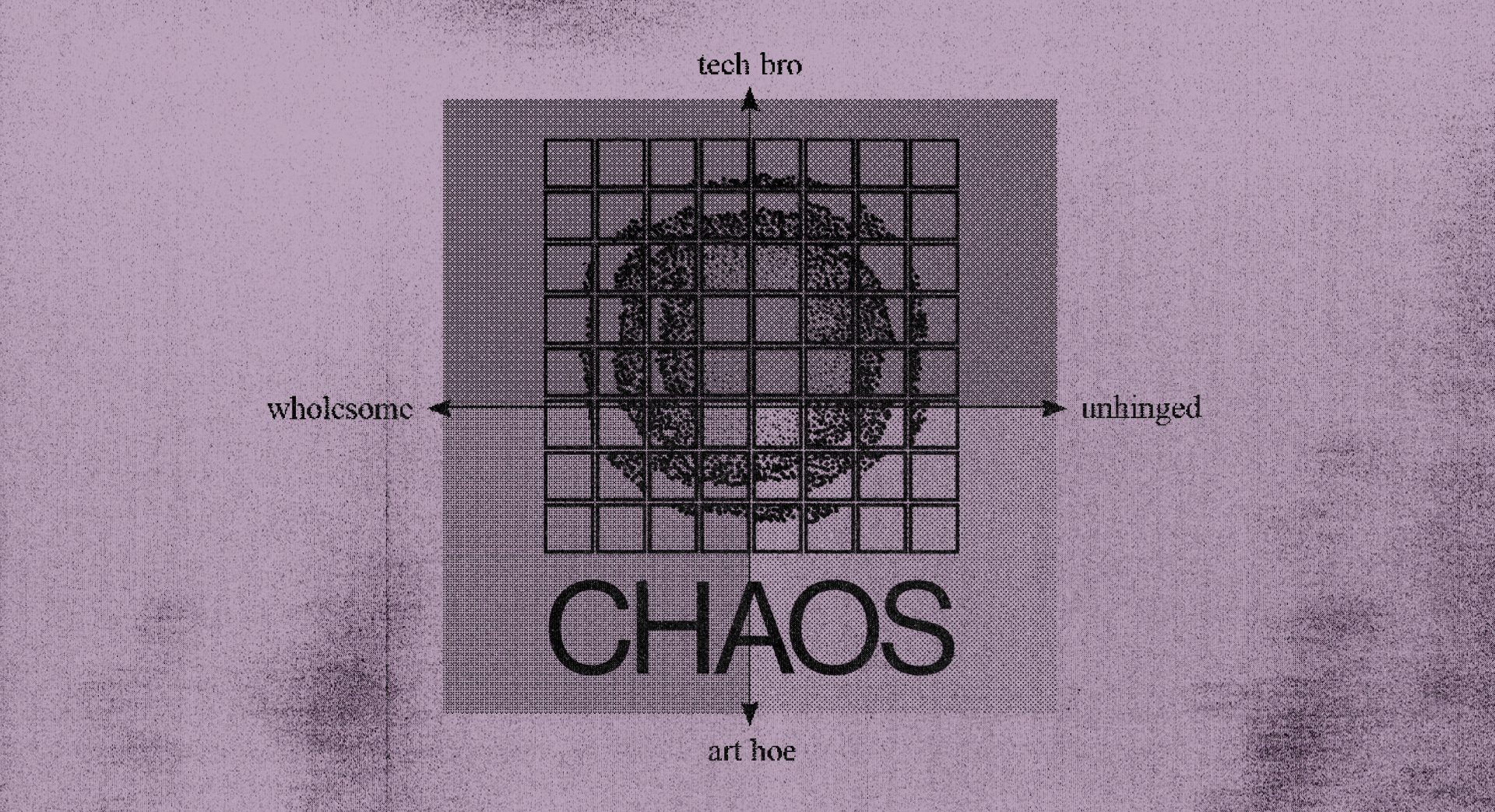
Despite the emphasis on chaos, I wonder to what degree coherency was necessary to coordinate effectively. Did you have to employ certain strategies to reach consensus and move forward together as a unit?
Matthew: A running joke has been that Chaos is the most organized project we've done so far, and it’s because of these containers we've designed to make people feel oriented when they show up. For the three of us here — including a handful of other people — Camp Chaos actually started late last year, because we've been designing and integrating learnings from Elektra to create something [more] coherent. Those containers have been very successful in getting us to where we are, and now we are starting to reach the edge of where we can design those containers to, where it now really falls more into the network's hands. I think we're slowly feeling our way through how we make decisions together as we let those containers go and look towards the future as a vast expanse of possibility.
Mark: It’s a coordination question, right? How do you coordinate a group of this size? There are a few concepts or fundamentals that we have explored in this project. One, as Matthew touched on, is containers: time-bound, spatial, experiential containers [such as “scope,” which outlined the end goal of the entire project for clear mission alignment, and “teams,” which detailed strategies for groups of people with different creative skill sets to blur together as one]. Another tactic is “default to open.” All of our channels are defaulted to open to foster greater transparency and context for all participants. Most of our decision-making comes, not from consensus, but more consent-based decision-making — looking for objections, rather than wider consensus on everything. The question is, Would this cause harm to the network? If not, we move forward. That makes it much speedier and [leads to] clearer timelines, which is related to containers. An adaptive and experimental mindset is like our front-end framing. Once [these containers are] introduced and people get that context, they're much more adaptive and flexible as they go.
Greydient, dev and econ steward, operations: One thing I would add is, at the start of camp, you have to build trust. There is no inherent trust, because you're all new to the network, so you're gonna have to have rigidity in your structure, because that contains the chaos, for lack of a better word. But as time goes on, you're building more and more trust in the network, and the network [slowly] delegates more trust to you. By the end of it, you have a better sense of who's in the network, what they're capable of, and how much you trust them.
Part of what fascinates me about Web3 is this experimentation with time, particularly duration. We can see it in the concept of seasons, in speedrun DAOs that are built for a singular mission before dissipating. What was it like for you all to coordinate within these time-specific restrictions? Were there any challenges you didn't anticipate?
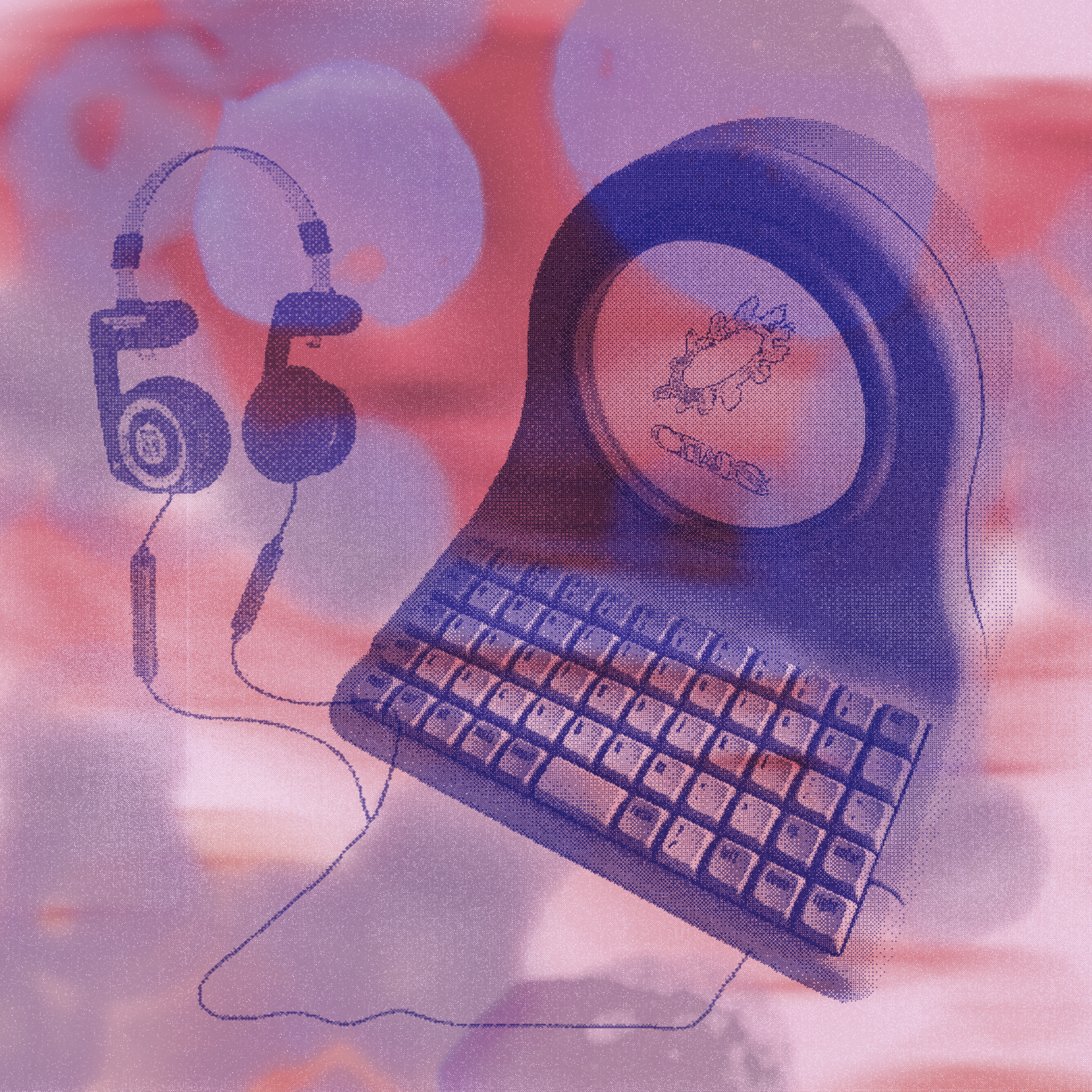
Mark: In this specific cohort, it's the first time that we have in-house developers building our smart contracts, building our split system. I lack the same technical understanding of what the phases are and what an agile workflow looks like, so, I’m like, Oh, this can be done in X amount of weeks — cool, easy. But then I realize that if you want to audit certain smart contracts, it takes more time to ensure that everything falls into place.
Greydient: To counter [that], I think we did a really good job of what we did know, which was how to make music, how to gather people to do that, and how to get the art done. I would say about 90 percent of the project exceeded my expectations. I used to be a management consultant, so I know how projects work: You can plan them down to the subtask, and things will still go wrong. So the fact that we ended up creating 45 songs [and artwork] in six weeks is still insane to me.
Can you explain how compensation works at Chaos? What was your ultimate goal with the economic design?
Matthew: I think the successful part of how we designed time in this camp was how we also draped in some of that lore: We referred to two-week cycles as "Acts." This is actually a nice segue to the value flow, because our value flow cycles were run in these two-week rhythms as well. Every Act, musicians had to start and finish a song with a new band, and every Act you had to basically reward contributors and yourself.
A big learning from the last camp was [that] we were already playing in this almost headless band world, without giving a name to it. Because a lot of people are creating artwork together in these different teams, [there can be] blurred lines about who's creating what. We were making it so artists were directly exposed to the value of our work that they specifically created, and that meant having to create all sorts of different percentage pies and slicing them up with different teams and artists. That created a whole host of long conversations [that involved] raw, vulnerable moments of “I made this. You made that.” It was very sticky and difficult.
This time, we decided, what if we pendulum-swing the other way and say: “OK, no one is exposed to the distinct artwork that they create. We are a headless band. We are giving up our individual selves here and creating something for the whole, so we will all be exposed to the value of the greater whole that we create.”
To break down how that split is dynamically flowed through the network — because not everyone has an equal share of that pie, since it's based on relative contribution — we devised the value flow system to have a few different parts. The first one was Coordinape, where you're [gifting tokens] to your peers and flowing percentage points to them every two weeks [based on the value you believe they added to the project]. Also every two weeks, we had a self-selection form, and this — opposite of Coordinape — is “This is how much I deserve.” You get a form and, pure honor system, signal how much you worked in the last two weeks. For that, you can either opt out of receiving [a percentage of the split in $CHAOS tokens] or you can opt in low, opt in medium, or opt in high. We kept the definition of what that means pretty vague: We didn't want to say “based on the time you put in” or “based on the impact you had.” We keep it very abstract for the reason of not making it an exact science. It's more of an art.
The last piece was holdback. We kept 10 percent of this pie held back, so that [a committee of 14 members from Camp Chaos, including team stewards, music guides, and core operations members] can make the decision to flow value to emergent and undervalued work that was less visible in camp and therefore did not receive [as much]. And so that's the full scope of what we did, [but] we also included a base UBI. It's a lot.
I appreciate that you are embracing some of the more interesting aspects of Web3: hyperstructures, the messiness of collective behavior, UBI, retro payments, splits, etc. But I also love this prioritization of lore. How entrenched was Eris in the process? What kind of presence did Eris have throughout?
Greydient: One of the cool things that ended up happening was the lore itself was almost community-founded. We have a member of our community named Shamanic, and they introduced this idea of Discordianism when we started talking about Camp Chaos. They were like, “Oh, you know, we used Discord as our tool of communication, and there's this whole religion of Discordianism.” So they introduced us to Eris, this Goddess of Discord. Matt and some of our lore-writing team embraced that and started pulling elements of Eris and her story into the camp.
All of the camp is very much filled with lore, and there's one Act worth of images that are very heavily based on Eris. But even the Acts — where the artists took their inspiration from Order, Disorder, Entropy, Rebirth — were very much around this theme of Eris. I think those informed the feelings people had in those particular weeks, and we used Eris and her lore as vehicles to present information to the campers.
One of the cool things we talked about was how storytelling pulls you in in a more focused way than a set of instructions would. I think this world-building aspect helps you reframe things. You almost end up acting like a kid again: You have no restraints, you have this freedom, and you’re operating in this new world. You can feel a lot of that energy within the music and the art that you're gonna see.
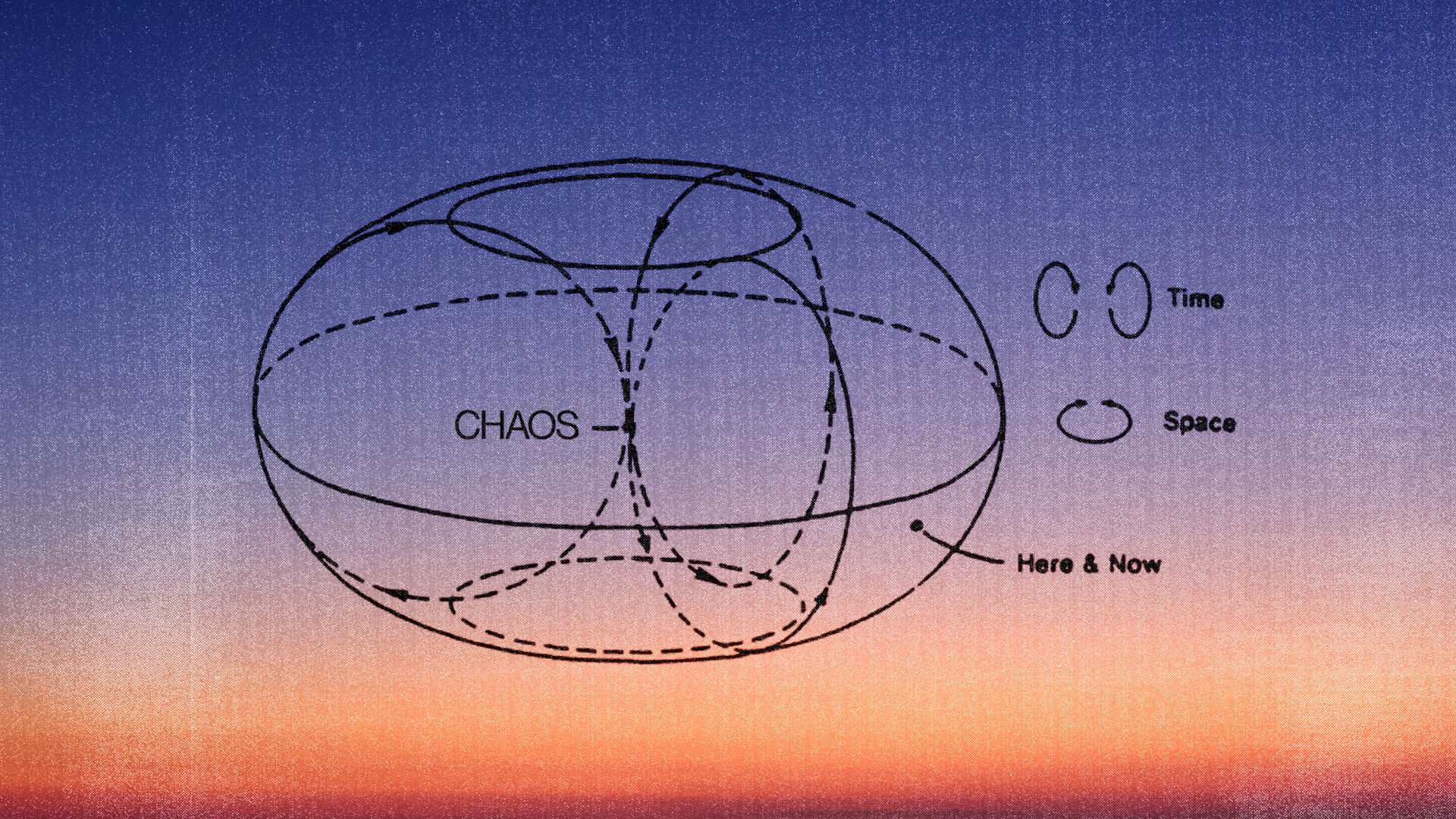
One of my favorite aspects of this project is the minting mechanism. Can you explain how it works and why you went this route?
Matthew: On June 3, 5,000 Chaos Packs will become available, much like a pack of Pokémon cards. People will be able to collect a pack, and then you could choose to open your pack or keep your pack closed, much like with a physical pack of cards.
If you open your pack, what you’re actually doing is burning your Chaos Pack NFT and randomly minting four of the songs. I have to shout out to a very high-contributing member of Songcamp since Elektra, Will Juergens, who brought this idea of not minting the songs themselves, but minting packs of songs. We're creating so much music, so how do you create direct experiences for people with some of the music and some of that artwork? You can't take in 45 songs easily. It’s like more than three albums. So each pack is almost like a unique custom EP of the bigger project. And maybe those four songs or the artwork create a more direct link to the project for you. We built an exciting UI so people can actually feel the impact of opening the pack, [so we could] make that a fun experience.
It’s like the minting process — similar to the lore — becomes a performance of the Chaos brand itself.
Greydient: Yeah, and you can choose to consume the songs in interesting ways. You can do them by Acts, for example, because the songs will hold a certain feeling based on whatever word was given to name that Act. Like, Order feels a bit more put together, and I think as the camp goes on, you'll feel the songs get more and more chaotic. But it's interesting that, as an EP, you’ll get to shuffle around those songs, and maybe they go together in a way that you never would have thought of.
This question comes from Yuri, a Songcamp alumnus and resident FWB pianist: How does Songcamp differ from other music NFT projects out there? Is there a sense of unfulfilled promise that underlies the current state of music NFTs?
Mark: Songcamp is a little different from other music NFT projects, as it strongly values collective creation. In a musical landscape that puts the solo artist genius on a pedestal, a whole community creating an ego-less body of work feels more interesting and novel.
It's great to see my peers releasing music NFTs, and I value the experimentation and willingness to dive deep in the technology and explore capturing the value of their work. I do love to see more music scenes and communities explore the space collectively. There is strength in numbers and a sense that you're not doing it alone.
Matthew: Songcamp is simply a place for curious musicians and other artists to find each other and run experiments at the edges of Web3. It is not a specific music NFT project; it’s a space for projects to sprout out from. This affords us the ability to try something new every time and never grab too tightly to any one mode or mechanic. We offer up each project as an experiment for the whole space to learn and gain inspiration from.
The second question is rather subjective, so I'll answer personally: I don't feel a sense of unfulfilled promise with regards to NFTs at all. They are not a solution, but a canvas. I think if they are seen as a salve to musicians' problems, they will fall short every time. If they are used by artists in creative ways, more and more people will see that their true nature is that of a medium to play with. This is where the potential for artist empowerment lies — not in empty conversations around scarcity and utility and the like. We haven't seen one iota of the places we can take this medium. If we stagnate around some early use cases and call this the thing, then any promises of change will surely fail to deliver.
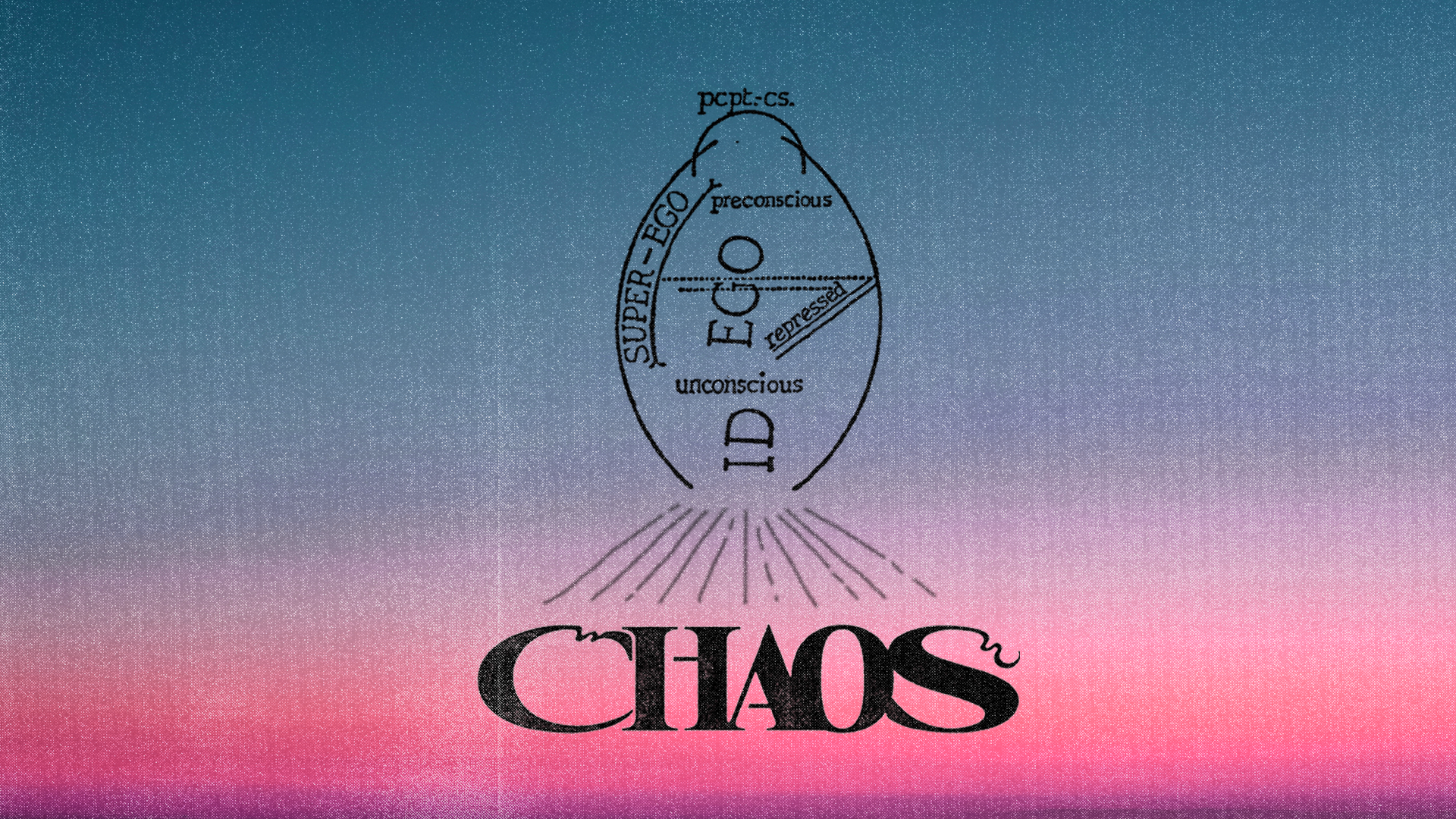
Any guesses as to how people will interact with the mint experience when it goes live?
Greydient: We built into the minting platform and site a way for you to see which NFTs you've collected across all three Acts of the music. So you can see that you have a song from Act 1, Scene 4 — we call them “scenes” instead of “bands” — kind of like in a Bingo card-style inventory system. Our hope is that collectors will try to fill out all their songs, or potentially get just one Act or one Scene from each Act. So there are novel ways to collect, and we've spoken internally about how we can incentivize or gamify that beyond just the actual collection aspect. There are a lot of great ideas on how we can build that collector-artist relationship and grow what headless Chaos can become in the future.
Matthew: We designed this project, but the output of it is so incredibly different from the input, such that I think everyone in camp is going to receive this project like someone who wasn't even a part of the camp. Because even if you're working heavily on the music side, or the visual side, or the dev side, when all these pieces fit into each other, it creates this whole new thing that feels bigger than anything we went into designing on the front end.
I love how there’ll never be a definitive version — like, no 12-track album that everyone can have consensus around.
Mark: Camp itself prides itself [in being] a laboratory where music and Web3 smash together. And what does a laboratory do? It researches. It experiments. At first, it's a hypothesis, and then we deploy an experiment. And we're big on documenting our learnings, both internally and publicly, really outlining the process of things. I hope that this could be seen as a contribution, not only to the Web3 music space, but to the music space in general. Like, Here's how we've done it. Please take inspiration from it, please remix it into your own. We have a strong open source-like ethos, a building-on-top-of-each-other ethos, which I think the Web3 community really embodies.
Greydient: It feels like festival day is gonna be the day the project goes from everything that Songcamp has done to get it there to becoming a project of the network. And that's where each member of the network, starting from that day onwards, is responsible for stewarding how the project moves forward. That's when I think Songcamp — as stewards who are crossing this project over the finish line and are holding it in place for us — becomes an equal in the network to everyone else. That excites me. I think it's gonna be quite crazy.
Matthew: Something I discovered is the power of making art as a network. Obviously, we're all collectively creating this project through many different mediums, but we're also experimenting with the network as a canvas. For an example of that, we've been doing these things called “murmurations” — started mainly by Levi Downey, who's been doing the Chaos radio project — within the camp. They happen in our weekly calls, where we all create something together. An example: We recently all recorded ourselves right then and there on a call, with our voices making the sounds we make to get to our form of creation. So if you’re a musician, maybe that means opening your notebook, getting your pen, turning on your Ableton session, mic’ing yourself up, hitting your guitar. Everyone did that, and we smushed it all together into this very clackety, amazing piece of audio of all of our sounds before creation into one sound.
To me, it was an early hint at what’s possible when you create these very mature coordination systems, like the way starlings create these murmurations together: What can a network do if it starts to move as one thing, if it really starts to dance as one?
Graphics by Fiona Carty.


